Kullanıcı:Nataliemeoww/Taslak/Bit başı işlem
Bu maddedeki bilgilerin doğrulanabilmesi için ek kaynaklar gerekli. (August 2018) (Bu şablonun nasıl ve ne zaman kaldırılması gerektiğini öğrenin) |
Şablon:Use dmy dates Bilişimde, bir bit başı işlem (İngilizce: bitwise operation) bir bit dizininin, dizisinin ya da (bit dizini olarak değerlendirilen) bir ikili sayının bitlerinin üzerinde tek tek uygulanır. Daha yukarı-düzey aritmetik işlemlere esas olan süratli ve basit bir işlemdir, ve işlemci tarafından doğrudan desteklenmektedir. Çoğu bit başı sistem, sonucun giriş terimlerinden birini değiştirdiği birer iki terimli işlem olarak gösterilir.
Basit, düşük fiyatlı işlemcilerde bit başı işlemler çoğu zaman bölme, çarpma ve toplamadan daha hızlı çalışır. Modern işlemciler daha uzun komut hatları ve başka mimari tasarım tercihlerinden dolayı toplama ve çarpmayı bit başı işlemler ile aşağı yukarı aynı hızla çalıştırsa da, bit başı işlemler daha düşük kaynak kullanımlarından dolayı daha az enerji harcar.[1]
Bit başı işlemler[değiştir | kaynağı değiştir]
In the explanations below, any indication of a bit's position is counted from the right (least significant) side, advancing left. For example, the binary value 0001 (decimal 1) has zeroes at every position but the first (i.e., the rightmost) one.
DEĞİL[değiştir | kaynağı değiştir]
Bit başı DEĞİL (İngilizce: bitwise NOT) ya da bit başı tümleme (İngilizce: bitwise complement), her bit üzerine tümleme uygulayan, verilen ikili değerin bire tümleyenini oluşturan tek terimli bir işlemdir. 0 olan bitler 1, 1 olan bitler 0'a döner. Mesela:
DEĞİL 0111 (onlu tabanda 7)
= 1000 (onlu tabanda 8)
DEĞİL 10101011 (onlu tabanda 171)
= 01010100 (onlu tabanda 84)
Sonuç, değerin ikiye tümleyeninin bir eksiğine eşittir. Eğer ikiye tümler aritmetik kullanılıyorsa, DEĞİL x = -x - 1
İşaretsiz tam sayılar için, bir sayının bit başı tümlemesi o sayının (2'nin bir üssü üzerinde) aralığının yarısı boyunca bir "ayna yansıması"dır. Mesela, 8-bit işaretsiz tam sayılar için, DEĞİL x = 255 - x. Bu, bir grafik üzerinde 0'dan 255'e doğru artan bir aralığı "tersine çeviren" aşağıya doğru giden bir doğru olarak gösterilebilir. Basit ama açık bir örnek, her pikselin işaretsiz birer tam sayı olarak muhafaza edildiği renksiz bir görseli tersine çevirmektir.
VE[değiştir | kaynağı değiştir]

Bit başı VE, eşit uzunluklu iki adet ikili ifade alıp her bit çifti üzerine mantıksal VE işlemini uygulayan bir ikili işlemdir. O halde, eğer kıyaslanılan konumdaki bitlerin her ikisi de 1 ise, sonuçtaki bit 1'dir (1 × 1 = 1); değilse, sonuç 0'dır (1 × 0 = 0 ve 0 × 0 = 0). Mesela:
0101 (onlu tabanda 5) VE 0011 (onlu tabanda 3) = 0001 (onlu tabanda 1)
The operation may be used to determine whether a particular bit is set (1) or cleared (0). For example, given a bit pattern 0011 (decimal 3), to determine whether the second bit is set we use a bitwise AND with a bit pattern containing 1 only in the second bit:
Bu işlem, belirli bir bitin aktif (1) ya da inaktif (0) oluşunu belirlemek için kullanılabilir. Mesela, 0011 (onlu tabanda 3) bit dizisinde ikinci bitin aktifliğini kontrol etmek için sadece ikinci bitinde 1 içeren bir dizi ile bit başı VE'si hesaplanabilir:
0011 (onlu tabanda 3) VE 0010 (onlu tabanda 2) = 0010 (onlu tabanda 2)
Sonuç 0010 sıfıra eşit olmadığı için orijinal dizide ikinci bitin aktif olmadığı anlaşılır. Genelde buna bit maskeleme (İngilizce: bit masking) denir. (Benzer şekilde, maskeleme kağıtları, ya da maskeler, ilgi konusu olmayan ya da değiştirilmemesi gereken kısımları kapatır. Bu durumda, 0 olan değerler ilgi konusu dışındadır.)
Bit başı AND, her bir bitin Boole'sal bir hali temsil ettiği bir yazmacın seçili bitlerini kaldırmak için de kullanılabilir. Bu yöntem, birkaç adet Boole'sal değeri asgari hafıza kullanarak muhafaza etmenin etkili bir yoludur.
Mesela, 0110 (onlu tabanda 6) birinci ve dördüncü değerin inaktif (0), ikinci ve üçüncü değerlerin ise aktif (1) olduğu sağdan sola sıralı dört değer olarak görülebilir. Üçüncü değer sadece üçüncü bitte sıfır içeren bir dizi ile bit başı AND uygulanması ile inaktifleştirilebilir:
0110 (onlu tabanda 6) VE 1011 (onlu tabanda 11) = 0010 (onlu tabanda 2)
Because of this property, it becomes easy to check the parity of a binary number by checking the value of the lowest valued bit. Using the example above:
Bu özellik sayesinde, ikili bir sayının paritesini kontrol etmek, sadece en düşük değerli bite bakmaktan ibarettir. Yukarıdaki örneği kullanmak gerekirse:
0110 (onlu tabanda 6) VE 0001 (onlu tabanda 1) = 0000 (onlu tabanda 0)
6 VE 1 sıfır olduğu için, 6 ikiye bölünür ve çifttir.
OR[değiştir | kaynağı değiştir]

A bitwise OR is a binary operation that takes two bit patterns of equal length and performs the logical inclusive OR operation on each pair of corresponding bits. The result in each position is 0 if both bits are 0, while otherwise the result is 1. For example:
0101 (decimal 5) OR 0011 (decimal 3) = 0111 (decimal 7)
The bitwise OR may be used to set to 1 the selected bits of the register described above. For example, the fourth bit of 0010 (decimal 2) may be set by performing a bitwise OR with the pattern with only the fourth bit set:
0010 (decimal 2) OR 1000 (decimal 8) = 1010 (decimal 10)
XOR[değiştir | kaynağı değiştir]

A bitwise XOR is a binary operation that takes two bit patterns of equal length and performs the logical exclusive OR operation on each pair of corresponding bits. The result in each position is 1 if only one of the bits is 1, but will be 0 if both are 0 or both are 1. In this we perform the comparison of two bits, being 1 if the two bits are different, and 0 if they are the same. For example:
0101 (decimal 5) XOR 0011 (decimal 3) = 0110 (decimal 6)
The bitwise XOR may be used to invert selected bits in a register (also called toggle or flip). Any bit may be toggled by XORing it with 1. For example, given the bit pattern 0010 (decimal 2) the second and fourth bits may be toggled by a bitwise XOR with a bit pattern containing 1 in the second and fourth positions:
0010 (decimal 2) XOR 1010 (decimal 10) = 1000 (decimal 8)
This technique may be used to manipulate bit patterns representing sets of Boolean states.
Assembly language programmers and optimizing compilers sometimes use XOR as a short-cut to setting the value of a register to zero. Performing XOR on a value against itself always yields zero, and on many architectures this operation requires fewer clock cycles and less memory than loading a zero value and saving it to the register.
If the set of bit strings of fixed length n (i.e. machine words) is thought of as an n-dimensional vector space over the field , then vector addition corresponds to the bitwise XOR.
Mathematical equivalents[değiştir | kaynağı değiştir]
Assuming , for the non-negative integers, the bitwise operations can be written as follows:
Truth table for all binary logical operators[değiştir | kaynağı değiştir]
There are 16 possible truth functions of two binary variables; this defines a truth table.
Here is the bitwise equivalent operations of two bits P and Q:
| p | q | F0 | NOR1 | Xq2 | ¬p3 | ↛4 | ¬q5 | XOR6 | NAND7 | AND8 | XNOR9 | q10 | If/then11 | p12 | Then/if13 | OR14 | T15 | ||
|---|---|---|---|---|---|---|---|---|---|---|---|---|---|---|---|---|---|---|---|
| 1 | 1 | 0 | 0 | 0 | 0 | 0 | 0 | 0 | 0 | 1 | 1 | 1 | 1 | 1 | 1 | 1 | 1 | ||
| 1 | 0 | 0 | 0 | 0 | 0 | 1 | 1 | 1 | 1 | 0 | 0 | 0 | 0 | 1 | 1 | 1 | 1 | ||
| 0 | 1 | 0 | 0 | 1 | 1 | 0 | 0 | 1 | 1 | 0 | 0 | 1 | 1 | 0 | 0 | 1 | 1 | ||
| 0 | 0 | 0 | 1 | 0 | 1 | 0 | 1 | 0 | 1 | 0 | 1 | 0 | 1 | 0 | 1 | 0 | 1 | ||
| Bitwise equivalents |
0 | NOT (p OR q) |
(NOT p) AND q |
NOT p |
p AND (NOT q) |
NOT q |
p XOR q | NOT (p AND q) |
p AND q | NOT (p XOR q) |
q | (NOT p) OR q |
p | p OR (NOT q) |
p OR q | 1 | |||
Bit shifts[değiştir | kaynağı değiştir]
The bit shifts are sometimes considered bitwise operations, because they treat a value as a series of bits rather than as a numerical quantity. In these operations, the digits are moved, or shifted, to the left or right. Registers in a computer processor have a fixed width, so some bits will be "shifted out" of the register at one end, while the same number of bits are "shifted in" from the other end; the differences between bit shift operators lie in how they determine the values of the shifted-in bits.
Bit addressing[değiştir | kaynağı değiştir]
If the width of the register (frequently 32 or even 64) is larger than the number of bits (usually 8) of the smallest addressable unit, frequently called byte, the shift operations induce an addressing scheme from the bytes to the bits. Thereby the orientations "left" and "right" are taken from the standard writing of numbers in a place-value notation, such that a left shift increases and a right shift decreases the value of the number ― if the left digits are read first, this makes up a big-endian orientation. Disregarding the boundary effects at both ends of the register, arithmetic and logical shift operations behave the same, and a shift by 8 bit positions transports the bit pattern by 1 byte position in the following way:
Little-endian ordering: a left shift by 8 positions increases the byte address by 1, a right shift by 8 positions decreases the byte address by 1. Big-endian ordering: a left shift by 8 positions decreases the byte address by 1, a right shift by 8 positions increases the byte address by 1.
Arithmetic shift[değiştir | kaynağı değiştir]
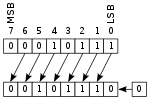
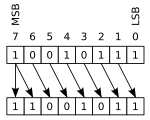
In an arithmetic shift, the bits that are shifted out of either end are discarded. In a left arithmetic shift, zeros are shifted in on the right; in a right arithmetic shift, the sign bit (the MSB in two's complement) is shifted in on the left, thus preserving the sign of the operand.
This example uses an 8-bit register, interpreted as two's complement:
00010111 (decimal +23) LEFT-SHIFT = 00101110 (decimal +46)
10010111 (decimal −105) RIGHT-SHIFT = 11001011 (decimal −53)
In the first case, the leftmost digit was shifted past the end of the register, and a new 0 was shifted into the rightmost position. In the second case, the rightmost 1 was shifted out (perhaps into the carry flag), and a new 1 was copied into the leftmost position, preserving the sign of the number. Multiple shifts are sometimes shortened to a single shift by some number of digits. For example:
00010111 (decimal +23) LEFT-SHIFT-BY-TWO = 01011100 (decimal +92)
A left arithmetic shift by n is equivalent to multiplying by 2n (provided the value does not overflow), while a right arithmetic shift by n of a two's complement value is equivalent to taking the floor of division by 2n. If the binary number is treated as ones' complement, then the same right-shift operation results in division by 2n and rounding toward zero.
Logical shift[değiştir | kaynağı değiştir]
 |
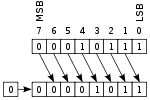 |
In a logical shift, zeros are shifted in to replace the discarded bits. Therefore, the logical and arithmetic left-shifts are exactly the same.
However, as the logical right-shift inserts value 0 bits into the most significant bit, instead of copying the sign bit, it is ideal for unsigned binary numbers, while the arithmetic right-shift is ideal for signed two's complement binary numbers.
Circular shift[değiştir | kaynağı değiştir]
Another form of shift is the circular shift, bitwise rotation or bit rotation.
Rotate[değiştir | kaynağı değiştir]
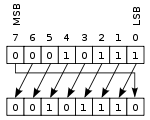 |
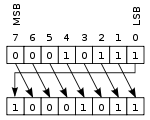 |
In this operation, sometimes called rotate no carry, the bits are "rotated" as if the left and right ends of the register were joined. The value that is shifted into the right during a left-shift is whatever value was shifted out on the left, and vice versa for a right-shift operation. This is useful if it is necessary to retain all the existing bits, and is frequently used in digital cryptography.Şablon:Clarification needed
Rotate through carry[değiştir | kaynağı değiştir]
 |
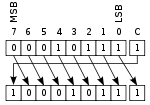 |
Rotate through carry is a variant of the rotate operation, where the bit that is shifted in (on either end) is the old value of the carry flag, and the bit that is shifted out (on the other end) becomes the new value of the carry flag.
A single rotate through carry can simulate a logical or arithmetic shift of one position by setting up the carry flag beforehand. For example, if the carry flag contains 0, then x RIGHT-ROTATE-THROUGH-CARRY-BY-ONE is a logical right-shift, and if the carry flag contains a copy of the sign bit, then x RIGHT-ROTATE-THROUGH-CARRY-BY-ONE is an arithmetic right-shift. For this reason, some microcontrollers such as low end PICs just have rotate and rotate through carry, and don't bother with arithmetic or logical shift instructions.
Rotate through carry is especially useful when performing shifts on numbers larger than the processor's native word size, because if a large number is stored in two registers, the bit that is shifted off one end of the first register must come in at the other end of the second. With rotate-through-carry, that bit is "saved" in the carry flag during the first shift, ready to shift in during the second shift without any extra preparation.
In high-level languages[değiştir | kaynağı değiştir]
In C family of languages[değiştir | kaynağı değiştir]
In C and C++ languages, the logical shift operators are "<<" for left shift and ">>" for right shift. The number of places to shift is given as the second argument to the operator. For example,
x = y << 2;
assigns x the result of shifting y to the left by two bits, which is equivalent to a multiplication by four.
Shifts can result in implementation-defined behavior or undefined behavior, so care must be taken when using them. The result of shifting by a bit count greater than or equal to the word's size is undefined behavior in C and C++.[2][3] Right-shifting a negative value is implementation-defined and not recommended by good coding practice;[4] the result of left-shifting a signed value is undefined if the result cannot be represented in the result type.[2]
In C#, the right-shift is an arithmetic shift when the first operand is an int or long. If the first operand is of type uint or ulong, the right-shift is a logical shift.[5]
Circular shifts[değiştir | kaynağı değiştir]
The C-family of languages lack a rotate operator (although C++20 provides std::rotl and std::rotr), but one can be synthesized from the shift operators. Care must be taken to ensure the statement is well formed to avoid undefined behavior and timing attacks in software with security requirements.[6] For example, a naive implementation that left-rotates a 32-bit unsigned value x by n positions is simply
uint32_t x = ..., n = ...;
uint32_t y = (x << n) | (x >> (32 - n));
However, a shift by 0 bits results in undefined behavior in the right-hand expression (x >> (32 - n)) because 32 - 0 is 32, and 32 is outside the range 0–31 inclusive. A second try might result in
uint32_t x = ..., n = ...;
uint32_t y = n ? (x << n) | (x >> (32 - n)) : x;
where the shift amount is tested to ensure that it does not introduce undefined behavior. However, the branch adds an additional code path and presents an opportunity for timing analysis and attack, which is often not acceptable in high-integrity software.[6] In addition, the code compiles to multiple machine instructions, which is often less efficient than the processor's native instruction.
To avoid the undefined behavior and branches under GCC and Clang, the following is recommended. The pattern is recognized by many compilers, and the compiler will emit a single rotate instruction:[7][8][9]
uint32_t x = ..., n = ...;
uint32_t y = (x << n) | (x >> (-n & 31));
There are also compiler-specific intrinsics implementing circular shifts, like _rotl8, _rotl16, _rotr8, _rotr16 in Microsoft Visual C++. Clang provides some rotate intrinsics for Microsoft compatibility that suffers the problems above.[9] GCC does not offer rotate intrinsics. Intel also provides x86 intrinsics.
Java[değiştir | kaynağı değiştir]
In Java, all integer types are signed, so the "<<" and ">>" operators perform arithmetic shifts. Java adds the operator ">>>" to perform logical right shifts, but since the logical and arithmetic left-shift operations are identical for signed integer, there is no "<<<" operator in Java.
More details of Java shift operators:[10]
- The operators
<<(left shift),>>(signed right shift), and>>>(unsigned right shift) are called the shift operators. - The type of the shift expression is the promoted type of the left-hand operand. For example,
aByte >>> 2is equivalent to((int) aByte) >>> 2. - If the promoted type of the left-hand operand is int, only the five lowest-order bits of the right-hand operand are used as the shift distance. It is as if the right-hand operand were subjected to a bitwise logical AND operator & with the mask value 0x1f (0b11111).[11] The shift distance actually used is therefore always in the range 0 to 31, inclusive.
- If the promoted type of the left-hand operand is long, then only the six lowest-order bits of the right-hand operand are used as the shift distance. It is as if the right-hand operand were subjected to a bitwise logical AND operator & with the mask value 0x3f (0b111111).[11] The shift distance actually used is therefore always in the range 0 to 63, inclusive.
- The value of
n >>> sis n right-shifted s bit positions with zero-extension. - In bit and shift operations, the type
byteis implicitly converted toint. If the byte value is negative, the highest bit is one, then ones are used to fill up the extra bytes in the int. Sobyte b1 = -5; int i = b1 | 0x0200;will result ini == -5.
JavaScript[değiştir | kaynağı değiştir]
JavaScript uses bitwise operations to evaluate each of two or more units place to 1 or 0.[12]
Pascal[değiştir | kaynağı değiştir]
In Pascal, as well as in all its dialects (such as Object Pascal and Standard Pascal), the logical left and right shift operators are "shl" and "shr", respectively. Even for signed integers, shr behaves like a logical shift, and does not copy the sign bit. The number of places to shift is given as the second argument. For example, the following assigns x the result of shifting y to the left by two bits:
x := y shl 2;
Other[değiştir | kaynağı değiştir]
- popcount, used in cryptography
- count leading zeros
Applications[değiştir | kaynağı değiştir]
Bitwise operations are necessary particularly in lower-level programming such as device drivers, low-level graphics, communications protocol packet assembly, and decoding.
Although machines often have efficient built-in instructions for performing arithmetic and logical operations, all these operations can be performed by combining the bitwise operators and zero-testing in various ways.[13] For example, here is a pseudocode implementation of ancient Egyptian multiplication showing how to multiply two arbitrary integers a and b (a greater than b) using only bitshifts and addition:
c ← 0
while b ≠ 0
if (b and 1) ≠ 0
c ← c + a
left shift a by 1
right shift b by 1
return c
Another example is a pseudocode implementation of addition, showing how to calculate a sum of two integers a and b using bitwise operators and zero-testing:
while a ≠ 0
c ← b and a
b ← b xor a
left shift c by 1
a ← c
return b
Boolean algebra[değiştir | kaynağı değiştir]
Sometimes it is useful to simplify complex expressions made up of bitwise operations, for example when writing compilers. The goal of a compiler is to translate a high level programming language into the most efficient machine code possible. Boolean algebra is used to simplify complex bitwise expressions.
AND[değiştir | kaynağı değiştir]
x & y = y & xx & (y & z) = (x & y) & zx & 0xFFFF = x[14]x & 0 = 0
x & x = x
OR[değiştir | kaynağı değiştir]
x | y = y | xx | (y | z) = (x | y) | zx | 0 = xx | 0xFFFF = 0xFFFFx | x = x
NOT[değiştir | kaynağı değiştir]
~(~x) = x
XOR[değiştir | kaynağı değiştir]
x ^ y = y ^ xx ^ (y ^ z) = (x ^ y) ^ zx ^ 0 = xx ^ y ^ y = xx ^ x = 0x ^ 0xFFFF = ~x
Additionally, XOR can be composed using the 3 basic operations (AND, OR, NOT)
a ^ b = (a | b) & (~a | ~b)a ^ b = (a & ~b) | (~a & b)
Others[değiştir | kaynağı değiştir]
x | (x & y) = xx & (x | y) = x~(x | y) = ~x & ~y~(x & y) = ~x | ~yx | (y & z) = (x | y) & (x | z)x & (y | z) = (x & y) | (x & z)x & (y ^ z) = (x & y) ^ (x & z)x + y = (x ^ y) + ((x & y) << 1)x - y = ~(~x + y)
Inverses and solving equations[değiştir | kaynağı değiştir]
It can be hard to solve for variables in Boolean algebra, because unlike regular algebra, several operations do not have inverses. Operations without inverses lose some of the original data bits when they are performed, and it is not possible to recover this missing information.
- Has inverse
- NOT
- XOR
- Rotate left
- Rotate right
- No inverse
- AND
- OR
- Shift left
- Shift right
Order of operations[değiştir | kaynağı değiştir]
Operations at the top of this list are executed first. See the main article for a more complete list.
See also[değiştir | kaynağı değiştir]
References[değiştir | kaynağı değiştir]
- ^ "CMicrotek Low-power Design Blog". CMicrotek. Erişim tarihi: 12 August 2015.
- ^ a b JTC1/SC22/WG14 N843 "C programming language", section 6.5.7
- ^ "Arithmetic operators - cppreference.com". en.cppreference.com. Erişim tarihi: 2016-07-06.
- ^ "INT13-C. Use bitwise operators only on unsigned operands". CERT: Secure Coding Standards. Software Engineering Institute, Carnegie Mellon University. Erişim tarihi: 7 September 2015.
- ^ "Operator (C# Reference)". Microsoft. Erişim tarihi: 14 July 2013.
- ^ a b "Near constant time rotate that does not violate the standards?". Stack Exchange Network. Erişim tarihi: 12 August 2015.
- ^ "Poor optimization of portable rotate idiom". GNU GCC Project. Erişim tarihi: 11 August 2015.
- ^ "Circular rotate that does not violate C/C++ standard?". Intel Developer Forums. Erişim tarihi: 12 August 2015.
- ^ a b "Constant not propagated into inline assembly, results in "constraint 'I' expects an integer constant expression"". LLVM Project. Erişim tarihi: 11 August 2015.
- ^ The Java Language Specification, section 15.19. Shift Operators
- ^ a b "Chapter 15. Expressions". oracle.com.
- ^ "JavaScript Bitwise". W3Schools.com.
- ^ "Synthesizing arithmetic operations using bit-shifting tricks". Bisqwit.iki.fi. 15 February 2014. Erişim tarihi: 8 March 2014.
- ^ Throughout this article, 0xFFFF means that all the bits in your data type need to be set to 1. The exact number of bits depends on the width of the data type.
- ^ - is negation here, not subtraction
- ^ - is subtraction here, not negation
External links[değiştir | kaynağı değiştir]
- Online Bitwise Calculator supports Bitwise AND, OR and XOR
- XORcat, a tool for bitwise-XOR files/streams
- Division using bitshifts
- "Bitwise Operations Mod N" by Enrique Zeleny, Wolfram Demonstrations Project.
- "Plots Of Compositions Of Bitwise Operations" by Enrique Zeleny, The Wolfram Demonstrations Project.




![{\displaystyle {\begin{aligned}\operatorname {NOT} x&=\sum _{n=0}^{\lfloor \log _{2}(x)\rfloor }2^{n}\left[\left(\left\lfloor {\frac {x}{2^{n}}}\right\rfloor {\bmod {2}}+1\right){\bmod {2}}\right]=2^{\left\lfloor \log _{2}(x)\right\rfloor +1}-1-x\\x\operatorname {AND} y&=\sum _{n=0}^{\lfloor \log _{2}(x)\rfloor }2^{n}\left(\left\lfloor {\frac {x}{2^{n}}}\right\rfloor {\bmod {2}}\right)\left(\left\lfloor {\frac {y}{2^{n}}}\right\rfloor {\bmod {2}}\right)\\x\operatorname {OR} y&=\sum _{n=0}^{\lfloor \log _{2}(x)\rfloor }2^{n}\left(\left(\left\lfloor {\frac {x}{2^{n}}}\right\rfloor {\bmod {2}}\right)+\left(\left\lfloor {\frac {y}{2^{n}}}\right\rfloor {\bmod {2}}\right)-\left(\left\lfloor {\frac {x}{2^{n}}}\right\rfloor {\bmod {2}}\right)\left(\left\lfloor {\frac {y}{2^{n}}}\right\rfloor {\bmod {2}}\right)\right)\\x\operatorname {XOR} y&=\sum _{n=0}^{\lfloor \log _{2}(x)\rfloor }2^{n}\left(\left[\left(\left\lfloor {\frac {x}{2^{n}}}\right\rfloor {\bmod {2}}\right)+\left(\left\lfloor {\frac {y}{2^{n}}}\right\rfloor {\bmod {2}}\right)\right]{\bmod {2}}\right)=\sum _{n=0}^{\lfloor \log _{2}(x)\rfloor }2^{n}\left[\left(\left\lfloor {\frac {x}{2^{n}}}\right\rfloor +\left\lfloor {\frac {y}{2^{n}}}\right\rfloor \right){\bmod {2}}\right]\end{aligned}}}](https://wikimedia.org/api/rest_v1/media/math/render/svg/b873908a8c81ef7d63805b77756dbcf70a03b39c)